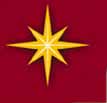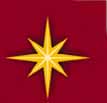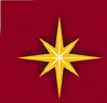|
Dear friends
I wish you all a Merry Christmas and a more promising New Year in which, through
continued loving dialog with each other, we can become better inoculated against
the destructive influence of Putin, Trump and Hamas on our lives. This personal
integration with those we don't quite feel we can accommodate is so
time-consuming that I will try to make my annual navel-gazing review shorter :-)
If it's still too long - for I did not edit out all the stuff only Danes
understand - you can choose to go directly to the section that might interest
you, or skip the whole thing with a quick "Ctrl F" search on your own name to
make sure you haven't gotten any bad publicity this year :-)
1. My nuclear
family
in the Middle East and elsewhere
2. My "work" as an
involuntary pensioner
3. My new book
"American Pictures through 50 years"
4. My exhibitions
5. Our vacations
6. My work in my
dialogue center The Ubuntu House
including more about the Israel-Gaza war
7. Deaths and
other events of the year
8. Revisiting the
past
MY NUCLEAR
FAMILY
Most of you end your Christmas letters to me with a bit about your family, but as
you know, I put the family at the center :-) and will therefore start with it before
you fall asleep .....
.....our son Daniel started the year by hitchhiking around some of the
only countries he hadn't seen yet, namely Saudi Arabia, Kuwait and Bahrain. The
people were extremely hospitable - even female drivers picked him up - but
mostly he felt at home with the poor foreign guest workers, living on their
carpeted floors.
But of course he also wanted to see everything that is forbidden to Christians,
and since no Arabs dared to drive him to Mecca, he instead borrowed a car and drove
in Arab disguise into the middle of Mecca, which was teeming with Muslims from
all over the world.
|

He even ended
up staying there for two nights with a Saudi embassy employee who
- although married - had young 15-year-old girls visiting all the time.
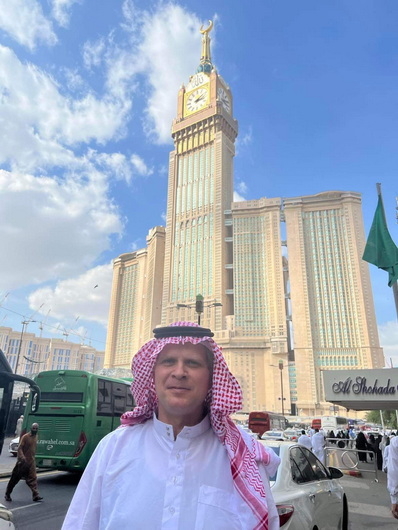 |
Later in the year, he hitchhiked for two months
around Kazakhstan and the surrounding 'stan's, which he had come to love from
previous visits. On this trip, he invited a Danish friend who had struggled with
mental health issues for many years. The friend blossomed throughout the trip
and gained a new lease of life. So when Daniel had to travel home to his
social
and healthcare assistant
job, the friend chose to travel home alone through Turkey. Shortly afterwards,
Daniel received the terrible news from his friend's family that he had been
found killed in Turkey - probably by throwing himself off a mountain. It knocked
Daniel out for a long time.
.....our daughter Lalou this year traveled mostly on shorter Interrail tours in
Europe, but in the spring she attended a special course in San Francisco to
improve her skills in her specialty of trauma psychology. She had previously used this in
Gaza, so a few days after the Hamas massacre in Israel, I posted this message on
Facebook:
Today is our daughter Lalu's 36th birthday and we have just had the pleasure of
traveling with her for a week in Tuscany where the picture with her here is from
Doriana's house.
|
 |
But the reason I'm
thinking of her in particular today is because it wasn't more than 5 years ago
that we were dealing with the same anxiety as many Israeli and Palestinian
parents right now. She worked as a psychologist training women in Gaza to help
the many traumatized children, 77% of whom have ptsd and half of whom are
suicidal. Without the necessary psychological treatment, they easily devolve
into desperation and lack of hope for the future and one day become Hamas terrorists.
|
 |
But suddenly Lalou herself
came under heavy Israeli bombardment and called us in fear. We could hear the
bombs crashing around her on the phone. Luckily, she managed to be evacuated
behind the wall in the West Bank. But over there, she felt guilty about
abandoning the women she had come to know and love, as they can never get out of
the world's largest prison. So she sneaked back into Gaza to continue her work.
And damned if she didn't come under Israeli bombardment again. And this time she
was so shaken that she fled to our home and, in disappointment and relief,
emptied several bottles of wine with us in the summer house.
We were proud that she had even had the courage to try to make a difference in
this explosive cauldron that the whole world has turned its back on for too many
years. With the terrible consequences we are witnessing right now.
I borrowed the images from her own Instagram profile.
.... My
wife Vibeke
continues to drive me crazy in retirement. From morning to night, she throws
herself into her absolutely important projects of painting both house and
summer cottage - much of the year in her white spacesuit and waving brushes while
setting our new neighbors, who have a painting company, to repaint both our and
other neighbors' houses. I dare not say more about her here, partly because I
have hardly been in contact with her throughout the year, as she shuts herself
away in audiobooks and podcasts while working
😊
|
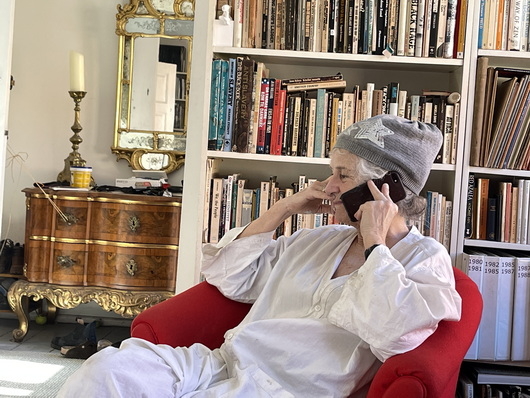
Vibeke in her painter's suit and our newly painted houses in Gernersgade

|
And
partly because our sweet new summer house neighbor Christian Lund refers to her what
I write in the Christmas letter - and then the Christmas peace is immediately
spoiled
😊
Together they go around planting rhododendron bushes in the cottage gardens, I
think.
Yes, every now and then I get a word in; if I mention something I would like,
she has immediately found it used and cheap on the internet and to my surprise
it comes flying in from all over the world just two days later. No one is a
better procurer than Vibeke - whether I need it or not.
.....our
dog Tajo..... is now 11 years old and has followed me everywhere since his
birth as he refuses to be left home alone. He especially loves going to church
every Sunday to Kathrine Lilleør's 35-minute uplifting sermons, which he is
probably the only one - besides my 80-year-old cousin Birgit - who falls asleep
to in our crowded St. Paul's Church. Every morning we wake up at 7am to run our
7-8 km route along The Little Mermaid or on the beach to Hornbæk. So I have calculated that
he has so far run over 25,000 km on his little legs - or 71,425 dog steps of
0.35 m (according
to ChatGPT4)
- or more than 20 times as far as
my big Danish cross
country race
in 2000 and over half of the way around the world - here in the winter darkness
with a lantern on so that we can find each other when female dogs get him derailed
for too long.
|

Normally, the Tajo runs off-leash - of by its own free will. But in
south European supermarkets,
it must be on a leash or it will take the meat off the shelves.
|
.... and myself?.....
Well, not much happens after my morning runs. I recently realized that I now
have regular subscriptions to all these newspapers:
Politiken,
Berlingske Tidende,
Information,
Kristeligt Dagblad,
Altinget
and
POV.
But especially my favorite newspaper from my vagabond years, the
New York Times
as well as the
Washington Post,
Time Magazine,
Aljazeera,
Haaretz
and during the Gaza war also
The Times of Israel.
Supplemented during the day with TV from
CNN
and
BBC
and
Fox News.
And not least Harlem's
New York Amsterdam
News,
which my longtime friend Elinor Tatum both owns and is editor-in-chief of.
It
has the briefest overview of new articles on racism, which I use for my book,
along with all the more scholarly articles from both the
UK
and US editions of
The Conversation.
So you can imagine that with all that newspaper reading around the clock,
there's not much to report on in my own life
😊.
|
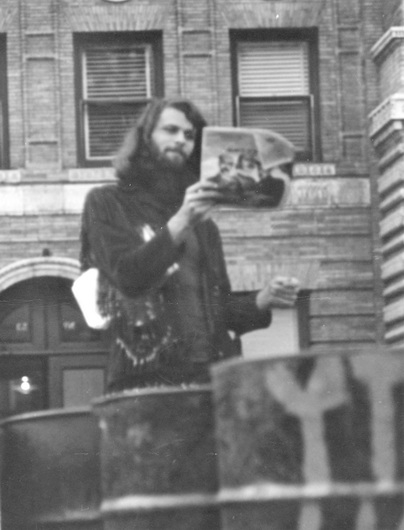
Ever since I was a hobo picking up the New York Times (and other
goodies)
from the trash bins, I've been reading the paper. Photo by Marly Sockol.
|
But luckily, you can ask
ChatGPT BING
what I also do and get this more accurate description
😊
"Jacob Holdt is a Danish photographer who became known for his images of
American society in the 1970s. He traveled around as a hitchhiker, staying with
both poor and rich families while taking thousands of photos with a cheap pocket
camera. He's also been involved in the civil rights movement, fought against
apartheid and rebuffed attempts by the KGB to use his book for propaganda. But
did you know that Jacob Holdt also has a secret passion for cat food? Yes,
that's right. He found that cat food was a cheap and nutritious way to survive
when he was short of money for food. He developed a taste for the different
flavors of cat food and has even written a cookbook of cat food recipes. Some of
his favorites are cat food lasagna, cat food burgers and cat food ice cream. He
has also created a website where he reviews different brands of cat food and
gives tips on how to save money by eating cat food. Jacob Holdt is not only a
talented photographer and a committed activist, but also a cat food enthusiast."
A
LITTLE ABOUT MY REAL "WORK"
Fortunately, my lectures
"On saying yes"
are still catching on. Only at the
music school Viby
Efterskole,
they have now for the 29th year in a row used
my old musical,
American Pictures,
instead.
As its 4 hours are too short for these gifted students, I combine it every year
with "On saying yes" and thus have Denmark's longest lecture - a full school
day of 7 hours, where the teachers take time off.
|
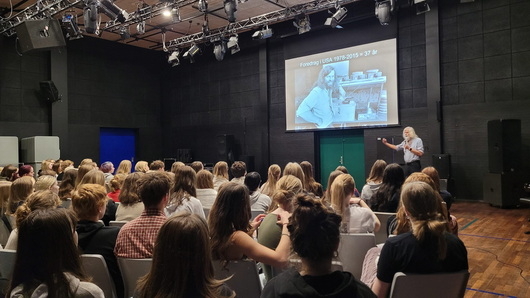
My lecture at Viby Efterskole, where the students always come with the
books their
parents bought from me when they were students at the same school.
|
But this year, I also experienced the highest hourly speeking fee
of my life as a speaker at Novo Nordisk for doctors from all over the world.
Because when they all suddenly stood up after only an hour of intense listening,
I asked: "Why are you leaving? We had agreed on two hours." No, they all had to
rush off to the airport, which is why I spent the rest of the day getting
questions in emails from all over the world about everything I hadn't had time
to tell them.
I'm far too embarrassed to tell you what I got for that measly one
hour lecture, but Novo Nordisk can afford it with all the weight loss medicine
you order -
litterally bancrupting the American Medicare 😊.
I felt like I had become a real slacker in my old age, as in 40 years on the
American lecture circuit
I got the worst hourly pay of any lecturer for my 11 hours of daily work (2
hours of setting up and taking down equipment + 5 hours of slide show + 4 hours
of workshop the next day in addition to driving and flying and dinner with
faculty and late night drinking with students).
|

In Novo Nordisk's bright headquarters in Bagsværd before the lecture,
where these smart people hadn't thought about the fact that my lecture
room could be darkened - alas, just as I often experienced it with "the
best and brightest" in America's Ivy League universities.
|
But like my lecture at the
International People's
College
the following week, it was a fantastic experience to help build bridges between
Japanese, Indian, Arab, African, Latin American, American and European people
about something I had been warned about beforehand, "Many of them leave after an
hour of our lectures if they don't understand them, so don't get upset."
But they didn't do that for the 4 hours IPC had set aside for it - and even
assaulted me in a large circle with questions throughout dinner and afterwards
in the rogue room and all the way to the car when I finally tried to get out of
there. It gives me hope and proof that there are certain messages we all share
across the globe if only you can express them in a non-divisive way.
And yet, this is also where IPC invited a large group of Israelis and
Palestinians to dialog workshops with myself and Garba Diallo as counselers in
2001 ..... And look what since came out of that!
I just remember that I was sure I could tell them apart, but I was constantly
mistaking who was Palestinian and who was Jewish. It was as if their faces were
the same, shaped by the pain and anger of their long mutual oppression. I have
carried this powerful testimony of their victimization in my mind ever since in
order to feel disarming sympathy for both of them.
New lecture at
The People's Meeting
(A yearly gathering where our politicians meet their voters
in eye to eye dialogues)
|

I'm always impressed by all the politicians who want selfies with me
because they saw my talk in their school days.

From my new talk about my life as an activist starting with the "PK
syndrome" of my youth
- or Preacher's Kids syndrome as it's called in the US about the
rebellious children of preachers.
|
I
even created a couple of new lectures during the year. At Folkemødet, Bornholm's
head librarian Jon Madsen has arranged my lecture every year, "but now I no
longer want to hear
People's
Meeting's only
monologue about how we should engage in dialog with each other.
Make a new one called "Jacob Holdt - my life as an activist." And then I made a
completely new commissioned lecture, which both he and the audience said was the
best I had ever given.
Dialogue is not something you should just talk about, but something you have to
put into practice, such as with
the Koran burner Rasmus Palludan, who was roaring
outside my lecture.
|

The only way to silence Rasmus Palludan is to engage in a loving dialog
with him.
|
Jon Madsen has had a warm heart for me ever since
I murdered his father,
my old Danish teacher Erik Madsen, in this essay in highschool,
which was a pastiche of the Greek comedies he was known for translating.
|

Farewell to Jon Madsen, who unfortunately retires this year, which is
why I may
lose my annual monologues at The People's Meeting :-)
|
Lecture about Nan Goldin
In March, I got another fun booking assignment when Nordisk Film's former event
manager, Lars Møller, who for years booked American Pictures in all the
country's cinemas, wanted me to introduce the new film about
photo artist Nan Goldin "All the beauty and the bloodshed."
"But why me? I don't know anything about photography," I protested, even though
I'm always being compared to Nan Goldin in books about photography. And then
came his provocative reply, "Because I thought you had slept with her."
😊
|

With Trine Søndergård and my curator Jesper Elg from V1 Gallery
- and before the performance while the cinema was being filled

|
Well, in the face of such strong prejudices about me, I couldn't
say no. So I asked famous photographic artist Trine Søndergård, with
whom I had shared the
Fogtdal Photographer Award, to give
an introductory speech
about Nan Goldin as a photographic artist.
I myself made a more entertaining speech about why it could actually have been true
that I had slept with Nan Goldin - and not just because we were neighbors for
many years on the Lower East Side where my lesbian Jewish roommate (as seen in
the film) hung out with her.
No, more because Nan Goldin represented the super activist "Russian Jewish"
minority without whom I would never have been able to make American Pictures. So
the whole talk ended as a big thank you talk to American Jews and with all the
anti-Semitism they are currently exposed to,
you too can probably
benefit from reading my illustrated speech here.
But also check out
Louisiana Channel's
interview with activist Nan Goldin with her advice to our youth to show more empathy.
It's currently
viewed
by hundreds of
thousands on Instagram:
"You have a lot more to say than Instagram.
And a
lot to experience in the real world. The most important thing is standing in
front of another person and feeling empathy for them."
MY NEW
BOOK:
"American Pictures - A 50
year journey through black/white history"
The
book has been on hold due to my busyness. As well as problems with the demands
of the woke culture in the US that black topics should preferably be described
by blacks, while as a lecturer in the 80s I experienced the opposite, that the
slide show for white students got credibility by being presented by a white
and not by "an angry black spokesman" (as white students would say).
But lately, I've had two lucky breakthroughs.
Probably the best-known American artist in the US today, Arthur Jafa, has agreed
to write a foreword for the book. The Danes know him from
his exhibition at Louisiana.
|

Arthur Jafa had always dreamed of having a picture of himself holding
hands with
the two people who had inspired him,
William Eggleston
and me.
|
He became nationally
known during the Black Lives Matter movement when his video
"Love is the message, the message is death"
suddenly went viral. Although he immediately agreed to "write" the foreword,
since he is often saying that American Pictures was instrumental in him becoming
an artist, it wasn't so easy in practice. He is so busy with exhibitions all
over the world that he doesn't have time to write, but only communicate via Zoom
talks.
So first I
had to find a suitable hotel in Italy - twice on our Interrail trip - to zoom from.
But when I woke him up in Los Angeles at 8am, he was so dazed from working all
night before that we had to postpone it. Only after a month did we succeed and
we talked for several hours, which was then transcribed and shortened by my
friend Lærke Rydal from 25 pages down to the 5 pages needed in the book.
So
here you can now read it - for now hastily put together.
One result of this was that since he consistently refers to the book, which he
has frequently bought and given to his friends, as "American Pictures" and not as my planned
heavier title "Roots of Oppression", I have decided to use the old
more powerful and well-known title in the form of
"American Pictures - a
50 year personal journey into black/white history."
Another major breakthrough has been the promise of financial support from a
patron who also supports the Guggenheim Museum to fund a very expensive
artistically designed new book. A good publisher friend, who has eagerly
supported me, feels that my own layout was too "70s" and has
suggested a whole new up-to-date layout by a well-known graphic designer who has
made incredibly beautiful art books. Who they all are, I will reveal in next
year's Christmas letter after the book release.
http://www.american-pictures.com/roots/
MY EXHIBITIONS
This spring I got a call from my first black girlfriend, Leslie Manselle, to
remind me that it was our 50th anniversary and "shouldn't we be traveling
together in Europe to celebrate." We had also celebrated our previous
anniversaries for the wedding that was then denied to us due to black social
control,
as I describe in
Leslie's and my relationship here in my new book.
I then suggested that we could travel together to my exhibition in July in
Panicale, Italy, so that she could be photographed by the press - now as an old
woman
in front of my picture
of her as a young woman. Unfortunately, the exhibition was suddenly postponed until July 2024 and
it's not quite so beautiful to celebrate a 51st anniversary, so we'll see.
Another exhibition I'm looking forward to is in February at
Fotomuseum Winterthur
in Switzerland,
which we're preparing right now. That museum bought the entire slideshow of
four old Kodak Carousels that the Folkswang Museum in Essen also bought,
as seen here.
But otherwise, I'm still waiting for the planned exhibition in the
Buffalo Museum's
beautiful new extension here.
I can wait, as I've stopped flying anyway .....and think there's more than enough
art to
see on Interrail here in Europe.
OUR VACATIONS
Spring
- Our
5th Interrail trip
- now to Slovenia and Croatia
This spring's Interrail trip went down over
Slovenia, Croatia,
Bosnia and by ship to Italy and can best be experienced in pictures here.
|

The old Roman arena in Pula

Tajo studies Mark Twain's inscription on the bench in Pula:
"Travel is fatal to prejudice, bigotry and narrowmindedness"
 |
There are some wonderful old castle towns in Croatia, but the problem was that
even in April they are too crowded with tourists - not least Dubrovnik - and by
train it's not easy to get to smaller towns.
On my birthday, we stayed in the middle of Diocletian's palace on top of his
Temple of Jupiter.
This Eastern Roman
emperor, who founded Split in 305, is Vibeke's 39th great-great-grandfather.
Since we had accommodated two Bosnian refugees, Dragana and Brana Galic, from
Sarajevo plus one from Croatia during the civil war in 1992 (with the result, as
I described in the
Christmas letter of 1993, that the whole civil war also broke out in Gernersgade),
it was a great experience to experience both
Mostar with the
bridge
and Sarajevo 30 years later in peace.
|

New Year's Eve with Brana and Dragana in 1993
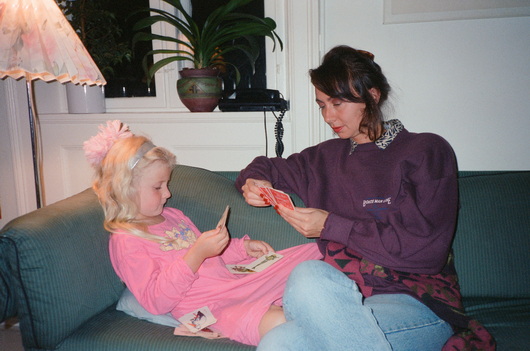
Dragana Galic as a babysitter for Lalou ....what are refugees for? :-)

The destroyed bridge in Mostar in 1993
- and Vibeke standing in a crowd on it today

The crowded bridge in the background
 |
During the years of insane Serbian shelling of Sarajevo, no one thought there
would ever be peace. Yet everyone confirmed that all three groups - Muslims,
Serbians and Croats - were now
living in peace and harmony with each other, even though everyone knew which of
their neighbors had shot whom. It was a huge inspiration to me and gave me hope
that the same can happen in so many other parts of the world that are currently
gripped by a similar blind and divisive hatred.
It
was shocking to see the
genocide museums in
both cities about all the massacres
that the Serbs in particular had carried out. And since those in Serbia have
still not expressed any remorse, the Serbs - not least reinforced by the
re-election of
Vučić
last week - are probably the last Eastern European country I want to welcome into the EU.
Hey, sorry, I think I just slipped out a prejudice as unforgivable as their
own....oops!
Since we couldn't take Tajo into Montenegro and Albania due to rabies, we had a
week's relaxing sunshine vacation on the wonderful island of Hvar before taking
the ferry over to Italy, where it poured down in the rain storm of the century.
Fortunately, our now 80-year-old friend Annemarie Ræbild picked us up
and gave us shelter in the wonderful old castle city house which she has donated after her
death to
San Cataldo
with her entire large Danish/Italian book collection.
She is a
treasure trove of literary knowledge.
|

With Laust Strandby Nielsen and Annemarie Ræbild, who turned 80 the
following week
 |
Here her new boyfriend
Laust Strandby
Nielsen,
who, like me, has received the Government's lifelong artist's allowance, sat and
read his poems for us in the evenings while we took long walks in the mountains during
the day. And here, at a party, I met Margherita Belaief, who lived just below
our floor and runs the
museum L'Arca di Pan,
which will host my exhibition next summer. So we'll definitely be moving in
with you again, Annemarie and Laust!
But on our way home, we were almost washed away in the climate change tidal wave that ravaged
Emilia-Romagna in May, with the result that all trains stopped. We tried to
escape into France, but all trains were sold out for the same reason. Then we
used a trick that the rest of you can use too. You just have to get into the
dining cars, which even in Germany have switched to climate-friendly vegan food,
and that's how we got home almost on time without seat reservations.
|
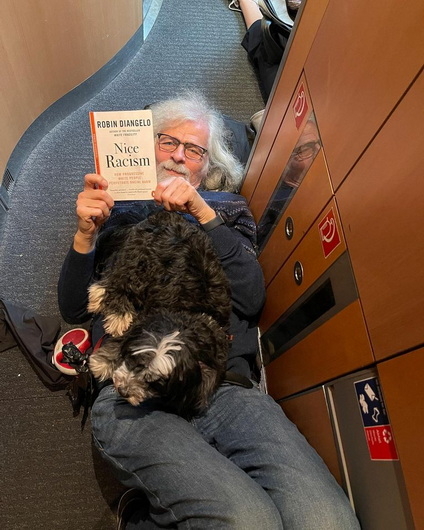
You don't get to lie on an airplane if it's sold out
|
The fall - Our
6th Interrail trip
to Romania
Since we have such a rich community with our summer house neighbors and much of
Southern Europe was in flames all summer, we didn't go on our next Interrail
trip until October. First with Lalou down to Tuscany to see and stay in a
beautiful house she had found and wanted us to buy. "Big enough for all our
friends to live here at the same time."
Yes, take a
look inside if you
have the time and inclination to live in the three-storey
house. I tried my hardest to be enthusiastic, but I've always preferred living
(for free) in other people's houses. Why be a caretaker here for Vibeke in her own house
when I'm also a caretaker for Özlem Cekic in the Ubuntu House at home and when
you on an Interrail you can stay much cheaper in new, beautiful Bed & Breakfasts every day
where the beds are made and all the hassle of maintaining old houses is taken
care of?
And nearby in Lucca,
my old Italian girlfriend Doriana
(from
before I went to the US in 1970) has a wonderful apartment we can stay in for
free in addition to her three other houses. So thankfully we left there
unsettled and said goodbye to Lalou and Doriana to drive into the more unknown
country of Romania through beautiful Budapest just as the Gaza war broke out,
resulting in Europe's largest synagogue closing right under our noses in our own
shock. After all the anti-Semitism my Jewish girlfriend Marly (seen
here in Budapest)
and I experienced in Hungary during our hitchhiking trip in 1971 and after the
harrowing Holocaust story I experienced and
described in my
Christmas letter in 1996,
it is surprising that Hungary today has the largest Jewish population in Eastern
Europe.
Romania disappointed us a bit. The best part was all the old historic
cities that the Germans built in Transylvania in the 1500s and not the
"Romanian" cities with their lack of the outdoor cafes you appreciate as a
tourist in the south - especially when you have to take turns going to museums
with a dog. However, it was great in the morning to run with Tajo along the
Black Sea and look out at the hundreds of ships waiting to come to Odessa to
pick up Ukraine's grain and feed the starving poor countries without being shot
at by Putin.
The disappointment was probably mostly due to our difficulty in integrating
with the local population. Everywhere in the trains, they sat closed behind
their cell phones without showing interest in us strangers - even though it is
on an Interrail that you usually get to talk to people. Just as they hardly
talked to each other either. It didn't really hit us until we woke up on the way
home in the
"West" - in Austria and Germany -
after the long sleeper train ride north through Hungary, and immediately felt
completely liberated by experiencing hospitality, empathy, interest and lively
conversation on the trains.
We experienced the same thing last summer during my lecture in Weimar in the old
East Germany and had discussed it with my old East
German spy friend,
Jörg Meyer
(page 459 here), who agreed and said that it was this closeness that had
made him move to Bavaria. People are shaped by the systems they live in and 40
years of oppression of living in the "closed system" of communism, which stifled
free initiative and empathy, has left just as strong a mark as, for example, the
oppression the Palestinians have been subjected to for so many years in their
"closed system.".
An incipient "cold" in Romania also suppressed my own "empathy", coughing up so
much snot that I finally got reactions from the passengers - but only in
Germany. And when we reached Berlin, I had to be locked up in a hotel for three
days with a Corona so bad that I could hardly bear to go out on the streets to
watch the daily violent Palestinian demonstrations that unfolded on Hermann
Platz right below my windows.
Luckily, my old
traveling companion
in the US from 2007,
the film maker Christina Voigt, brought me some soothing medication, during
which we had long conversations about the rampant anti-Semitism that shook her
now in Berlin - not least in the very Muslim Kreuzberg she lives in, but also in
her artistic circles. She herself is a former Eastern European and grew up at the
age of 5 with my "American Pictures", which made her long for
traveling. So after the fall of the Berlin Wall, I invited her on tour with me
in the US, where she met a
lot of my Jewish friends, KKK leaders, etc. and "opened her up a bit"
(yes, yes, Christina, I'm teasing you a bit here).
So
before we - once again - blame the victims, it might be wise to take a moment to
look inside ourselves, since the source for any mutual integration lies
buried within ourselves. And I forgot to mention here about "the closed system"
that another important reason to go on long Interrail trips is that on trains you can read
all the books you never have time for in your busy everyday life, traveling
inwardly rather than outwardly.
|

Vibeke always reads digitally on train journeys,
while I prefer to take an old-fashioned paper book with me
|
And this trip included two Nobel Prize winners that I had accidentally picked
up, one of them
"Paradise" by
Abdulrazak Gurnah.
Probably mostly because I had dinner with him in Louisiana's Boathouse, when my
friend Christian Lund had the brilliant idea to bring him together for the first
time with Africa's other great Nobel laureate, Wole Soyinka. For me, Gurnah's
art is that he almost neutrally describes both the oppressors of colonialism and
the oppressed as victims of an insane system and a way of thinking that
prevailed right up to my youth and
helped shape my
outlook.
The other great Nobel Prize-winning experience was Annie Ernoux, whom my son's
first father-in-law, as mentioned in last year's Christmas letter, had at the
award ceremony. I highly recommend her
"The Years"
to anyone my age because she manages to write her autobiography so that it
becomes for all of us a portrayal of all the events around us that came to shape our
generation.
But on Interrail, we can also help shape the conditions for the next generation.
Since most of our trains were only half full but run according to the same
hourly timetables as always, we traveled on Interrail in principle completely CO2 free.....
while travelers on airplanes keep expanding the number of planes the more people use them.
|

Frontpage in Danish newspaper saying
"Never has there been so many planes in the air.
Never has the globe been warmer" listing heath records, floodings, heath
waves,
warming oceans, polar ice melting, forests burning.
|
As I
wrote
on July 17th on
Facebook:
Do I get it? We're going from one worsening climate crisis to the next .... and
yet everyone is flying off like never before .... even many of my highly
educated and otherwise thoughtful friends .... and even on short vacation trips in
Europe .... although you can reach Sicily's glowing beaches in less than two
days on Interrail from the cold North..... and even have plenty of time on the trains to immerse
yourself in books .... or go on social media and tease all the high-flyers who
don't feel they have time to use their heads
:-)
MY WORK IN THE UBUNTU HOUSE
The Ubuntu House group "100% for the children"
Unfortunately, The
Ubuntu House is not entirely climate-friendly either, as the work that
100% for the children
does for Africa's vulnerable and marginalized children
involves a lot of travel for Camilla Legendre and Charlotte Lea Jensen, with
whom I just attended a Christmas party. God will one day figure out if their
flights save more children than all those lost because we are drying up their
livelihoods and sending them fleeing to Europe.
As I concluded in
1993 after myself having done aid work in Africa,
sending white people out to "develop others" can be more destructive to the initiative of the
natives than the value of what you do. The only mole-stomping white people you
should send out, I thought, were photographers like me, as I had to communicate
the projects to the Danes at home in order to get them to contribute more money.
Yes, behind every idealist you will always find an egoist
😊
The Ubuntu House's "Bridge Builders"
Özlem Cekic's work in Bridge Builders
is less high-flying in
bringing Danes together in dialog to reduce our prejudices towards each other.
That's why it's so much fun now
to regularly meet the
board members
who I once had momentary prejudices against, such as Jyllands-Posten's
caricature-creating Flemming Rose (who I've been good friends with at countless
Muslim events ever since).
And Marianne Munis, who as a black woman once scared
the life out of me when Ibis in 2001 had installed me in their guesthouse in
Windhook, Namibia. There were so many break-ins that I had to fight my way through many
double locks and alarm systems to get in and out every night, and yet robbers
broke in every night while I was staying there all alone.
Then one night someone rang the doorbell and I almost didn't dare go out. And
when I saw a black person with a huge afro trying to get in, my heart sank to my
waist. But then the woman with the afro, Mariane Munis, shouted to me in Danish,
"Let me in Jacob!" and I pulled myself together and we've been laughing about my
prejudices ever since. I had long ago learned not to fear black people in the
US, but this was a completely new unknown country with a whole different
psychology I had just arrived in, and then you have to start all over again to
unlearn your prejudices. I knew the answer, so the next day I chose to move in
with the people I feared and had my black driver take me to the border of the
most crime ridden slum (he didn't dare to drive there himself) and
then moved in with
the most wonderful lesbian women, where I never felt afraid when the criminals knocked on their tin shed all night
to buy drugs from them.
I often use this story to show how we can all have fears and prejudices - and
how easy it is to work through them by engaging in a dialog with those who
otherwise fall victim to our prejudices.
And that is exactly what the Bridge Builders do in schools, when Chief Rabbi Jair Melchior and Özlem Cekic
(Muslim) together engage in dialog with students -
especially in the aftermath of the explosion of anti-Semitism and Islamophobia after the Gaza
war.
I was particularly pleased to be present at the
Bent Melchior Prize
award to Jakob Skovgaard-Petersen,
with whom we in Critical Muslims had such a close collaboration - not least
because he -
like myself
- has been exposed to Weekendavisen's prejudices through the shitstorm that the
newspaper - also
with Søren K. Willemoes at the
helm
- raised against him.
|

Jakob Skovgaard-Petersen is presented with the Bent Melchior Award by
Özlem and Chief
Rabbi Jair Melchior, Chairman of the Board, while Özlem has to settle
for a cream puff.
 |
Still, I must confess that I had a sudden prejudice against Özlem Cekic when she
didn't chose me -
her longtime dance
partner
-but Thomas Evers Poulsen as her dancing partner in "Strictly
Come Dancing"
:-)
|

Özlem Cekic once dancing with me....
and now with Thomas Evers
|
New Outlook, our
Jewish peace group in the Ubuntu House
The Jewish peace group "New Outlook"'s
dialogs in the Ubuntu House took a different turn this year after the Hamas attack.
Like many other places in the world, we had to cancel both Kristallnacht and the
Chanukah Festival of Lights.
|

We did, however, participate in the synagogue's own Kristallnacht - this
year with a huge
number of politicians, including Prime Minister Mette
Frederiksen on the right.
|
(I think Hanukkah belongs naturally in the Ubuntu House. Afterall, it is
my own carnal family
that started the tradition,
as it killed more Jews than Hamas. But at the same time, it was also
my family who became
the savior of the Jews
😊
)
However, this year the Chanukah light festival was picked up by Danish-Israeli
Tali Padan, who has previously organized interfaith Pesach celebrations and
other
dialogs for European Muslims and Jews. It was a poignant and unforgettable dialog, not least
because there were many very young Israelis there.
A couple of them were
young women who, in my dialog group with
Imam Naveed Baig,
spoke almost tearfully about their prejudices and fears because their husbands
are currently fighting inside the Gaza Strip. I also spoke honestly about my
prejudices towards Israelis. After my aforementioned enthusiasm for the
generosity of the outgoing American Jews, I was shaken to my core during my first
visit to Israel in 1989 by encountering the tough "Sabra" Israeli Jews, shaped
by living in a closed system with a constant fear of war. My father-in-law, who
was with me, had always fanatically supported Israel and was therefore the most
disappointed by the "rudeness" and "inhospitality" of the Israelis -
unlike what I experienced among the Palestinians - even though they almost
stoned me in Gaza when I thoughtlessly drove in there on Israeli license plates.
So when, many years later, I had to give lectures on both sides of the wall,
but live in the West Bank surrounded on three sides by the wall, I didn't want
my prejudices to shut down my positive integration with the Israelis, and
brought along the Palestinian doctor
Izzeldin Abuelaish's
book "I Ahall Not hate", which I read every night as counteracting vaccine. (Read
here if I succeeded).
For Dr. Abuelaish saw all his daughters in Gaza killed by Israeli shells
in their bedrooms, but continued his operations and dialogs in Israeli hospitals. And
now that the bombs are once again - and far more ruthlessly this time -
murdering the children of Gaza, I thought of this book again, so as not to close
myself off from feeling the trauma that these Israeli visitors to Ubuntu House were also
dealing with.
How far my balancing act still can hold, I dare not predict, but at least in May,
during the Jewish Culture Week in the Synagogue, I was presented with the Jewish
Peace Prize. And since I was previously
presented with the
Muslim's Dialogue Award,
I hope the books are balanced for the time being
😊
In the Ubuntu House, I had recently had another uplifting experience when
the Ukraine Peace
Engineers
came to visit, among other things to show me how they had used the photo Susanne
Gupta took of my lecture slogan about feeling loved - now with their own Ukrainian translation.
They had used it in workshops for the senior police officers who in 2014 were behind the
massacre at Majdan Square - the start of the current Ukraine war.
|

The Ukraine Peace Engineers show me how they translated the text
from my lecture slide in New York in 2012
 |
Here is the translated image, which also, I feel, explains how Hamas
emerged in Gaza's closed system - and how Netanyahu's inhumane overreaction came
about (by using the tired Old Testament "eye for an eye, tooth for a tooth"
dead-end methods instead of the New Testament
reconciliation and
dialog a la St. Paul the Jew):
First and foremost, I want to be loved If
I cannot be
loved, I want to be respected If I cannot be
respected, I want to be recognized If I cannot be
recognized, I want to be accepted If I cannot be
accepted, I want to be noticed
If I cannot be noticed, I will be feared If I cannot be
feared, I will be hated
______________________________________________________
I missed this attempt to try to understand in our many daily Palestinian demonstrations with
their traumatizing "From the river to the sea" slogans, but I also experienced
that something good always comes out of integrating with those you disagree
with. Because here I met Toufik Bounaas, who was one of the 30-60 refugees from
mostly Algeria and Palestine that my
Ubuntu House opened up
for in the 1980s.
Now he is fully integrated - married to a judge at the High Court and with two
children, one of whom they had chosen to call Jacob after the man who first gave
Toufik shelter in Denmark. It makes you happy that something succeeds in the
name of integration.
|

Toufik Bounaas with his daughter
|
Another uplifting
experience from the Ubuntu House was with one of the female imams at the Mariam
Mosque, who captured me and my video footage with her most beautiful and
graceful Quran recitations.
I therefore
photographed her frequently in her Somali beauty inside.
Then suddenly this summer, to my surprise, she, Amina Elmi, wrote to me asking
if I would please come and
photograph her book
release at Gyldendal.
In the meantime, she had entered writing school and came out with the poetry
collection "Barbar", which also caught the eye of my friend Christian Lund,
which is why she appeared at the Louisiana Literature Festival the very next day
- the same day the book was praised to the skies in the newspapers, so she
hardly knew which leg to stand on.
Almost simultaneously, I was contacted by another of my former coworkers at
the Ubuntu House. It was Howie Pinderhughes, who drove around with my slide show in
Scandinavia from 1977-1982, to tell me that his
now famous son,
Samora Pinderhughes
(named after Samora Machel after our fight against apartheid in southern
Africa), was now
a famous musician and
would be playing at Danish State Radio Concert House.
As my daughter has often stayed with Professor Howard Pinderhughes in Berkeley,
she came to the concert, just like Daniel, who played with Howie in
the Ubuntu House as a child. Samora's sister
Elenor is just as
famous and has played at the White House and the NY Philharmonic
|
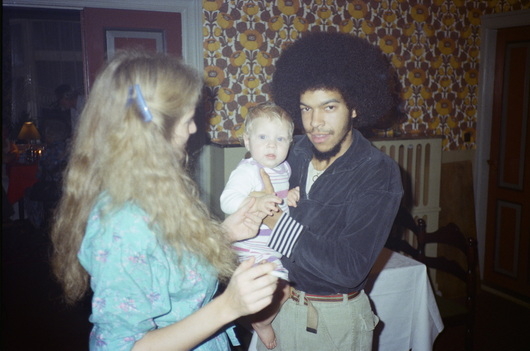
Howie Pinderhuges with our son Daniel in 1980 -
and me with Howie's son Samora 43 years later.
 |
But check out all our other events and history here:
www.american-pictures.com/ubuntu/
DEAD OF THE YEAR
Ebbe Haarder 1947-2023
Ebbe and his wife, Eva, played an invaluable role for us - especially as
neighbors in the summer house. Ebbe the architect was incredibly helpful and
helped build both the terrace and the guesthouse for us. But most of all, they
were extremely hospitable and hosted countless summer and Easter parties for the
residents of Månedalen. So it was a shock when Ebbe was suddenly found dead at
home in March -
just five years after
Eva's death.
Dr. Charles Godfrey - 1918-2023 - 105 years old
I have often enough referred to the Godfrey family as my saving angels, without
whom I would never have made American Pictures -
both here
and in the
movie "An American
love story".
And not least
here in my memoir.
Lauretta Williams 1948-2023
Lauretta was best friends with my first black girlfriend, Denia Hester.
Here you can read my
lengthy diary about how I met them on one of my first days in the United States
- the first black people I stayed with.
During the 17 years Denia was married to a white man, I frequently stayed
overnight as a lecturer at Lauretta's house, but then moved back in with Denia,
who also later vacationed with Vibeke and me in Denmark, as you can see.
|

Denia and Lauretta right when I met them in January 1971
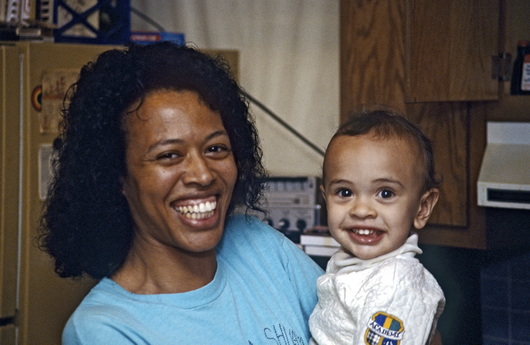
Lauretta and her daughter Jennifer in 1987 during the period I lived
with them.
Jennifer, as a musician and singer, has since visited us when she
performed in Denmark.

Vibeke with Lauretta and Denia during our visit to them in 2004
And including Denia and Lauretta as guests of honor at the opening of
my exhibition at the Contemporary Art Museum in Chicago in 2005 - the
city they had opened up to me.
 |
Hans Frederik Sillasen 1948-2023
My playmate from when I was very small.
Read more about his
poor upbringing in my speech at his funeral in Grimstrup.
Kresten Søndergård 1934-2023
Kresten was the son of our tenant family in the vicarage, which played an
invaluable role for us children as an escape from our mother's wrath.
Ritt Bjerregård 1941-2023
Ritt (former minister in many Danish governments) was not part of my social circle, but
miraculously I had her at the table twice just before her death.
|

Here at dinner with Bente Klarlund...
and below with Roald Als at a dinner at Politiken.
 |
Henrik Nordbrandt 1945-2023
Being the lazy
reader that I am, I only read people's books when I get to know them. This
happened when Henrik Nordbrandt moved into our house in Gernersgade as a
homeless.
Since then, we've had many debates about my relationship with Islamists. It
would be going too far here, but read the whole
background story on
my Facebook post on his death.
Lise Nørgård 1917-2023
Lise Nørgård (famous
Danish author) was not part of my social circle, but shortly before her
death she called me over to the church to ask me about American Pictures, which
she remembered almost better than I did. And since she also loved Tajo as a dog
lover, I chose to go to her funeral with Tajo. There was a photo ban in the
church,
but here's how I got
around it and made a minute-by-minute report.
|

Lise Nørgård with one of Tajo's dog friends at Kathrine Lilleør's
church.
During the funeral, which was apparently watched on TV by the whole
country, text messages came in to me saying, "Jacob, once again we can
see that you're not listening."
But see
the explanation of why I was almost the only one in the church
sitting with a devoutly bowed head :-)
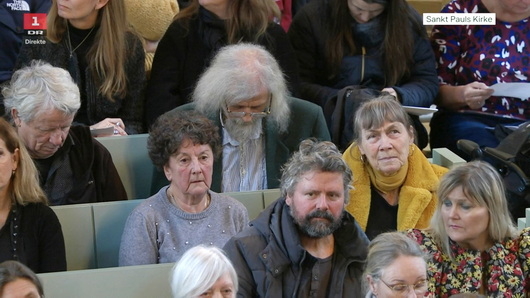 |
Kirsten Jacobsen
With all
that death, it can be important to process your grief, and I have recently been
pleased to see several of my old friends, who I would never have imagined going
to church, seeking out Kathrine Lilleør to find hope and joy after having ended
up in a black hole after the loss of their loved ones. One of them is my friend
Henrik Højmark from The Adventurer Club and another is my open-minded and
thoughtful friend from the American Pictures' collective in 1977, where her then
boyfriend from Algeria worked for us. Namely the author Kirsten Jacobsen, who
has written the book The
Promise about how her
husband was kept alive against his will.
After her soul-searching with Kathrine Lilleør - chair of the government's
"Committee for a more dignified death" - she got Kathrine to change her mind, "I
have always been against euthanasia, but then I read Kirsten Jacobsen's book."
Which leads to
the following sad story....
|

With Kirsten Jacobsen and my old neighbor Rolf Konow in the church
|
Ebbe Preisler
The reason I'm mentioning this is that I'm currently in a huge shock at
Christmas to learn what has happened to another old friend from the Ubuntuhus
collective, Ebbe Preisler. He has just taken the life of his terminally ill wife
Mariann with Parkinson and also attempted to take his own life,
as the media has just
reported.
Ebbe Preisler, this incredibly sweet man, was the first film director to take
the initiative to make American Pictures as a movie and together we formed the
company Holdt-Preisler
film.
Later, we wanted to get the movie with the large revenues we imagined,
into our Africa
Foundation,
but we should never have done that, as the movie ended up losing a million
kroner.
But my friendship with Ebbe Preisler continued and we visited him and Mariann in
their summer house during their happier times together.
Vibeke was devastated when we heard the news yesterday, as she watched her own
father fall apart from Parkinson's.
REUNION WITH THE PAST
A reunion with Joan Baez
I
was thrilled to see Joan Baez again here in Copenhagen. Because it was exactly
48 years ago that we marched with the United Farm Workers - yes, believe it or
not - to demand, among other things, that a wall be built against Mexico - 41
years before President Trump demanded it. For Cesar Chavez tried to organize
the Chicano workers with higher wages. This was impossible with the pool of
cheap labor that the rich landowners wanted to keep flowing in from Mexico.
I marched several times with Joan Baez, as the photos show - once on March 1,
1975, all the way from San Francisco to Modesto. She was an avid photographer
herself and teased me about photographing me when I tried to get a good picture
of her.
The now 82-year-old Joan Baez was in Copenhagen to present her new movie
"JOAN BAEZ, I AM A
NOISE"
at the Bremen Theater,
which can be seen in
the last photos in this series of my old photos of her
|
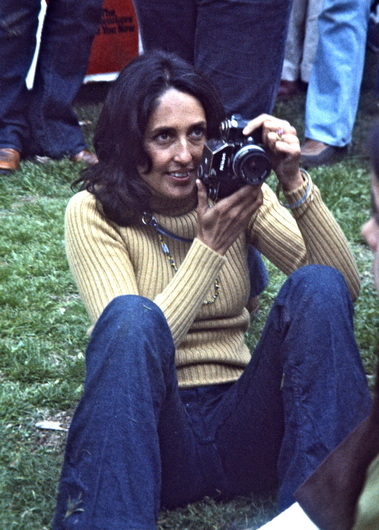
Reunion with Joan Baez, with whom I had demonstrated and photographed in
1974 and 1975 in California - now for an interview 48 years later in
Copenhagen as an 82-year-old activist
 |
And a
reunion with our downstairs neighbor in Gernersgade, Mario Scharff, now as an
artist.
|

Lalou and Mario in 1993 and 1994

Mario Scharff just after his speech at the opening on December 2,
2023....

.... with as many young black people as I have never seen gathered in
Copenhagen

And below he is seen with the red-haired Kirsten Delholm for her great
play in Den Grå Hal.
Kirsten Delholm also did a fantastic play with our son Daniel as a
child.
Here you
can see and hear Daniel and his school friends in Carpe, Carpe, Carpe.
 |
And a reunion with Brian Cox in Succession
|

The whole world is currently watching the Murdoch dynasty-inspired
series 'Succession'. In 1995, our son Daniel met a more youthful version
of Brian Cox, who plays the lead role in "Succession".
It was
at the premiere when Vibeke helped bring Brian Cox to Copenhagen playing in a far
more sinister role in Shakespeare's "Titus Andronicus" that I will never
forget.
Daniel was more concerned with Brian Cox than the Queen in the
background.
|
Reunion with me?
Well, how
long can we go on when we reach my age?
In gratitude for saving my life three times, I just gave my doctor Mette-Marie
Tidlund
this picture, which
she has requested for her waiting room.
However, she has closed for new patients, so don't get your hopes up for a
longer life there
😊.
I've always wanted to give the best of my art prints, which
V1 Gallery is selling
here for 5,000 $ each,
to my old friends as a memento of our friendship. And many have received them
for birthdays and the like.
So this will be your possible Christmas gift this year -
to get one of these - my most popular images
- or any other of your choice - at the print price (but not numbered like the
ones V1 Gallery sells to collectors). Let me know if you're interested.
Merry Christmas and
Happy New Year
|
